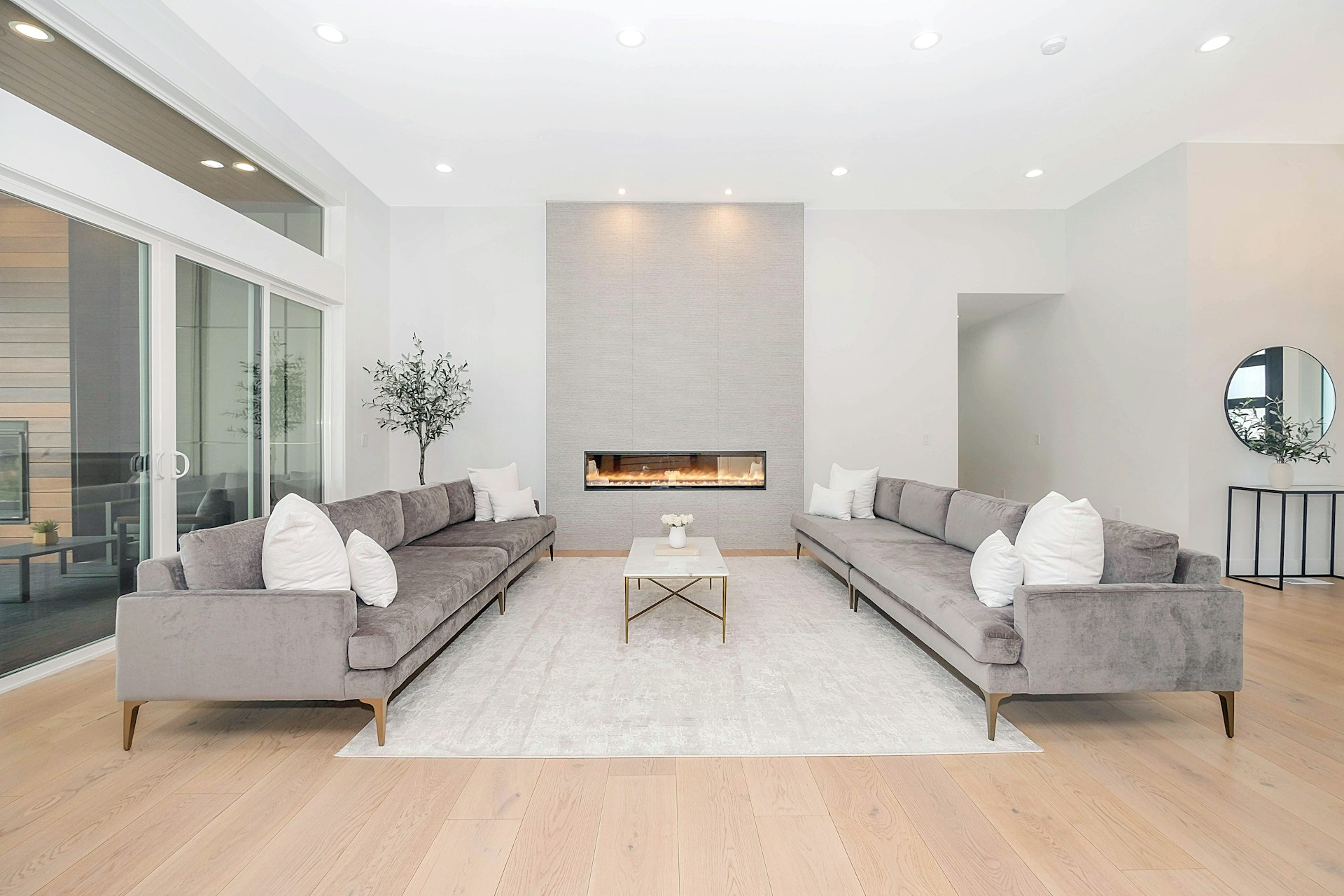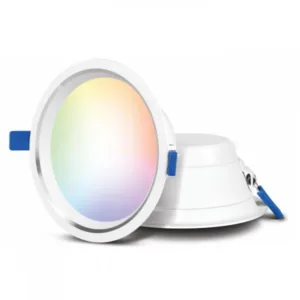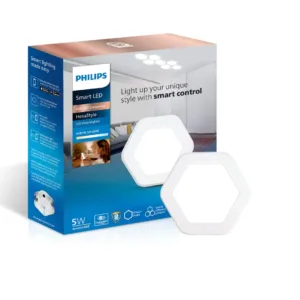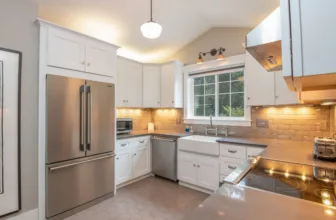
Smart downlights, also known as smart ceiling lights, are revolutionizing the way we illuminate our homes. These innovative devices offer a plethora of advantages, including convenience, energy efficiency, and personalized lighting control. Whether you’re looking to enhance your home’s ambiance, automate your lighting system, or simply enjoy the convenience of voice-activated control, smart downlights are a fantastic way to achieve your goals.
Introduction to Smart Ceiling Lights Setup
In today’s era of smart homes, transforming your living space with smart ceiling lights is a seamless way to blend technology with functionality. However, with so many alternatives available, selecting the correct Smart Ceiling Lights and installing them might be difficult. This Smart Ceiling Lights Setup Guide provides an in-depth exploration of smart downlights, from their pros and cons to the intricacies of connectivity technologies.
This comprehensive guide will also walk you through the setup of smart ceiling lights, focusing on setup, connectivity options, and the array of choices available for Smart Downlights in the market..
Understanding Smart Ceiling Lights
Smart Ceiling Lights, also known as recessed lights or panel lights, offer a sophisticated lighting solution for modern homes. These lights seamlessly blend into the ceiling, providing a sleek and unobtrusive appearance.

Smart Ceiling Lights: Pros and Cons
Before delving into the setup process, let’s explore the pros and cons of incorporating these intelligent fixtures into your home.
Pros:
- Convenience: Control your lights with your voice, smartphone, or smart home hub.
- Enhanced Security: Set routines to simulate home occupancy when you’re away.
- Energy Efficiency: Smart Downlights often come with LED technology and Automation capabilities, contributing to energy savings.
- Customization: Creating the right mood is essential in Ambient Lighting. Enjoy the flexibility to create custom lighting scenes, adjust brightness levels and color temperatures according to your mood or specific needs.
- Longevity: LED-based Smart Downlights tend to have a longer lifespan compared to traditional lighting options. The Automations and Schedules helps further in expanding lifespan of these LED lights.
Cons:
- Initial Cost: Smart Downlights may have a higher upfront cost compared to traditional lighting options.
- Complex Setup: Setting up smart downlights may require technical know-how, and troubleshooting can be challenging for beginners. The proper placement and right type of Smart Ceiling selection are the key aspects to make your space more elegant.
- Compatibility Issues: Ensure compatibility with your existing smart home system (Google Home
 Google Home is a smart home platform by Google that allows you to connect all of your compatible devices, manage them on your mobile device and control them using Nest smart speakers and displays. Google Homes Nest smart speakers were formally marketed as Google Home speakers. More, Amazon Alexa
Google Home is a smart home platform by Google that allows you to connect all of your compatible devices, manage them on your mobile device and control them using Nest smart speakers and displays. Google Homes Nest smart speakers were formally marketed as Google Home speakers. More, Amazon Alexa Amazon Alexa is Amazon’s cloud-based voice service available on hundreds of millions of devices from Amazon and third-party device manufacturers. More, Apple HomeKit etc.) to avoid potential issues. Communication methods (WIFI, Zigbee etc.) are also important to note.
Amazon Alexa is Amazon’s cloud-based voice service available on hundreds of millions of devices from Amazon and third-party device manufacturers. More, Apple HomeKit etc.) to avoid potential issues. Communication methods (WIFI, Zigbee etc.) are also important to note.
Connection Technologies in Smart Ceiling Lights
Smart Downlights employ various connection technologies, with Wi-Fi and Zigbee being prominent options. Understanding the connection technologies used in smart downlights is crucial for a seamless setup. The most common technologies are explained below.
Comparison of Connectivity Technologies:
| Technology | Range | Hub Required | Compatibility | Good Things | Constrains |
|---|---|---|---|---|---|
| Wi-Fi | Long | No | High | Wide range, easy setup | Susceptible to interference, higher power consumption |
| Bluetooth | Short | No | Moderate | Simple setup, low power consumption | Limited range, individual control required, susceptibility to interference |
| Z-Wave | Long | Yes | Moderate | Reliable connection, mesh network, extensive device compatibility | Requires a Z-Wave hub, less common |
| Zigbee | Long | Yes | Moderate | Mesh network enhances reliability and extended coverage, low power consumption | Requires a dedicated Zigbee hub, less common |
| Matter | N/A | N/A | High | Open-source, cross-platform compatibility, future-proof | Early stage, limited devices |
Bluetooth Downlights
Ideal for short-range communication between devices, Bluetooth is commonly used for connecting smartphones, speakers, and other peripherals to smart home devices. It has low energy consumption and offers simple pairing process. Bluetooth-only Smart Downlights have a limited range (usually 5m – 15m) and are susceptible to interference. You’ll have to stay very close to these lights to get good communication.
Smart Tip
Generally, avoiding the Bluetooth Smart Downlights is the right choice. Get it, if you have a small room(around 100 Sq.ft.) or you don’t plan to expand further.
Wi-Fi Downlights
Wi-Fi Downlights connect directly to your home Wi-Fi network, offering easy integration with other smart devices. They are suitable for standalone setups without the need for a dedicated smart home hub. WIFI has wide range and high data transfer speeds. But, it creates potential interference with other devices, especially with higher number of devices in the network. It also has higher power consumption.
Philips WiZ, Wipro Garnet, Halonix Prizm, HomeMate and EcoEarth Neo are some of the leading brands with good downlight choices available right now in the Indian market.
Smart Tip
If you don’t plan to have a broad expansion of smart home setup in your house, WIFI Ceiling lights are the best choice to keep things simple and cost effective.
Zigbee Downlights
Zigbee operates on the 2.4 GHz frequency band, which is a widely used spectrum and may experience interference from other devices like Wi-Fi and Bluetooth. Zigbee-enabled Downlights create a mesh network, enhancing communication between devices. While requiring a Zigbee Hub, this setup can improve overall reliability and extend the range of your smart lighting system. Zigbee provides extended coverage and has low power consumption.
Philips Hue lights are based on Zigbee protocol Zigbee is a secure Low-Power Mesh Networking Solution from CSA(Connectivity Standards Alliance) for IoT and Smart Home applications. Zigbee is a specification for high-level communication protocols using low-power digital radios, often used in smart home devices. An advanced wireless technology being built into home automation and smart energy devices; it is closely associated with the ‘Internet of Things‘. Zigbee devices... More. Its Muscari and Aphelion series ceiling lights are great premium lights for your living rooms.
Zigbee is a secure Low-Power Mesh Networking Solution from CSA(Connectivity Standards Alliance) for IoT and Smart Home applications. Zigbee is a specification for high-level communication protocols using low-power digital radios, often used in smart home devices. An advanced wireless technology being built into home automation and smart energy devices; it is closely associated with the ‘Internet of Things‘. Zigbee devices... More. Its Muscari and Aphelion series ceiling lights are great premium lights for your living rooms.
Smart Tip
If you have large number smart home devices, mesh networking is the way to go, eliminating the radio communication clutter and need of additional radio accessories (like WIFI Signal Boosters, WIFI Extenders etc.). Zigbee can create a reliable mesh network in your large smart living environment.
Z-Wave Downlights
Z-Wave protocol Z-Wave is a wireless communications protocol primarily used for home automation, allowing devices to communicate over a mesh network. A Network technology that enables all your home electronics to be controlled from a single wireless network. It’s easy to install with no complicated programming and no new cables to run, yet offers sophisticated control of your network. Any Z-Wave enabled device (from... More is optimized for low-power, short-range communication between smart home devices. Similar to Zigbee, this also requires a Z-Wave Hub. It operates in the sub-1GHz frequency range and supports mesh networking as well. Z-Wave is commonly used in home automation, with a strong presence in smart home devices and a focus on interoperability. Z-Wave devices may be slightly more expensive due to licensing fees associated with the Z-Wave standard.
Z-Wave is a wireless communications protocol primarily used for home automation, allowing devices to communicate over a mesh network. A Network technology that enables all your home electronics to be controlled from a single wireless network. It’s easy to install with no complicated programming and no new cables to run, yet offers sophisticated control of your network. Any Z-Wave enabled device (from... More is optimized for low-power, short-range communication between smart home devices. Similar to Zigbee, this also requires a Z-Wave Hub. It operates in the sub-1GHz frequency range and supports mesh networking as well. Z-Wave is commonly used in home automation, with a strong presence in smart home devices and a focus on interoperability. Z-Wave devices may be slightly more expensive due to licensing fees associated with the Z-Wave standard.
Despite the fact that Z-Wave has been popular in Smart Home for many years, it is difficult to find Z-Wave-based Downlights in India or abroad. The most frequent way is to use a Z-Wave Smart Light Dimmer in conjunction with a standard (non-smart) Downlight. To make this work, you’ll need a Dimmable LED or other conventional type of light source with a suitable Dimmer. However, because it only enables dimming, it cannot control RGB lights.
Smart Tip
Many Z-Wave Hubs also support WIFI. This means that you can operate Wi-Fi Downlights via the Z-Wave Hub.
Matter Supported Downlights
Matter is an emerging standard focused on increasing interoperability among smart home devices, leveraging IP and being supported by major industry players. Matter enhances security, ensuring seamless communication between various brands and devices. Matter’s goal is to improve interoperability by providing a unified standard for smart home devices, reducing fragmentation in the market.
Matter is a unifying standard that natively supports Wi-Fi, Ethernet, and Thread. Because its goal is to simplify smart homes, Matter allows devices that utilize other protocols, such as Zigbee or Z-Wave, to participate in the Matter ecosystem.
Since it is fairly new standard, brands are still working on the products to make them compatible with the Matter Standard Matter is a new standard for smart home devices, aiming to simplify connectivity and interoperability. Developed by the Connectivity Standards Alliance (CSA), it promises to unify existing smart home platforms and protocols, eliminating the need for separate hubs and apps for different devices. Here's a breakdown of the Matter Standard: Goal: • Create a unified smart home ecosystem. • Simplify... More. As of now, only few brands like Philips WiZ, Philips Hue, TP-Link Tapo, Nanoleaf, Govee etc. are compatible with Matter.
Matter is a new standard for smart home devices, aiming to simplify connectivity and interoperability. Developed by the Connectivity Standards Alliance (CSA), it promises to unify existing smart home platforms and protocols, eliminating the need for separate hubs and apps for different devices. Here's a breakdown of the Matter Standard: Goal: • Create a unified smart home ecosystem. • Simplify... More. As of now, only few brands like Philips WiZ, Philips Hue, TP-Link Tapo, Nanoleaf, Govee etc. are compatible with Matter.
Smart Tip
SmartLivingIndia recommends Matter Supported Smart Devices for future-proofing your smart home setup. Keep a watch on our blogs and shop archives for updates on Matter supported products and information.
Matter for Smart Home: The Future
The Matter aims to unify smart home devices across different platforms, making it easier to connect and control devices from different brands.
Because Matter operates on current technologies such as Wi-Fi, Ethernet, and Thread, many existing smart home products can and will be modified to support Matter through software upgrades. Product manufacturers can accomplish this by either updating the devices themselves or, in some situations, the bridges to which they are linked.
Matter simplifies device setup by utilizing numeric and QR setup codes, as well as Bluetooth Low Energy, allowing you to onboard it onto your network, apps, and/or platforms in a single flow.
Comparison of Matter Protocols:
| Protocol | Range | Power Consumption | Bandwidth | Suitable for |
|---|---|---|---|---|
| Matter over Wi-Fi | Long | High | High | General purpose, streaming, video communication |
| Matter over Thread | Medium | Low | Medium | Battery-powered devices, large networks, mesh networks |
| Matter over Ethernet | Wired | N/A | High | High-performance devices, reliable connection |
Future of Matter over Zigbee:
With the increasing adoption of Matter, we can expect to see more Zigbee-compatible devices entering the market. Additionally, advancements in Zigbee technology, like Zigbee 3.0, offer improvements in speed, range, and security, solidifying its position as a reliable and efficient solution for smart home connectivity.
Selecting the Right Connection Technology
Choosing the appropriate connection technology is pivotal for a reliable and future-proof smart lighting system. Consider the following factors when making your decision:
Importance of the Right Smart Home Connection Technology
The Connection Technologies serves as the backbone of your smart lighting system, influencing its performance and compatibility. A well-chosen communication technology ensures a seamless and interconnected smart home experience. Choosing the right one depends on your individual needs and preferences. Consider factors such as the size of your home, the number of smart devices you have, and your desired level of control.
Selecting a Smart Home Device Platform
A Smart Home Device Platform is the software or service that allows your smart lights to communicate with your smart home system.
Here’s a comparison table to help you choose:
| Platform | Pros | Cons |
|---|---|---|
| Amazon-Alexa | Wide compatibility, voice control | Limited customization, privacy concerns |
| Google-Assistant | Powerful integration, voice control | Limited device compatibility compared to Alexa |
| Apple-HomeKit | Secure, easy to use | Limited device compatibility |
| Samsung-SmartThings | Open platform, wide compatibility | Can be complex to set up |
Smart Home Device Platform you choose significantly impacts your smart ceiling lights experience. It’s important to choose a platform that is compatible with your existing smart lights and other smart home devices. Consider which platform you are already invested in and which features are most important to you. Here are some factors to consider:
Investing time in selecting the right platform will ensure a seamless and enjoyable smart lighting experience.
Exploring Downlight Types
Let’s explore the different types downlights available. The light source can be either SMD LED array or COB LED.
The Light Source
SMD LED Array
SMD is an abbreviation for “Surface Mount Devices” which means, these are assembled on a PCB directly without holes. The LEDS are placed in array of rectangular or circular form. Light diffusers and reflectors are added to spread the light evenly. These are affordable options that are offered.


COB LED
COB stands for “Chip-On-Board”. By directly imprinting an LED chip onto a PCB, this technology allows the chip to become a part of the board rather than a separate component. Although they cost a little more, they offer far greater value and performance.
Advantages of COB LEDs
Types of Downlights
Ceiling Downlights come in various types, each serving a specific purpose in lighting design:
Surface Mount Lights
Flat and often square or rectangular fits directly on the ceiling, offering a contemporary look. Ideal for larger spaces, surface mount panel lights distribute light evenly across the room. They come in various sizes and can be surface-mounted or suspended.

Flush Mount/Recessed Downlights
Flush mounted or recessed into the false ceiling, providing ambient lighting. These lights blend in with the ceiling, giving the area a sleek, contemporary appearance.

Deep Recessed Downlights
Deeply recessed into the false ceiling to provide very narrow beam of light. Consider factors like beam angle and color temperature when selecting deep recessed downlights.

Fixed Spotlights
Focused beams for highlighting specific areas. Not adjustable. Spotlights are versatile for accent lighting, but proper calculation of beam angles and optimal placement is crucial.

Adjustable Spotlights
Focused beams for highlighting specific areas or objects on the wall. These can be adjusted direct the light wherever you want.

Special consideration must be given to spotlights and recessed downlights when designing the ceiling.
Smart Tip
Philips HexaStyle Downlights are great for creating patterns on your ceiling due to its hexagonal shape.
Philips Smart HexaStyle Downlighter WiZ Connected Wi-Fi LED Light (Tunable White + Dimmable)
₹1,198.00 – ₹1,898.00Conclusion
Smart Ceiling Lights, particularly Smart Downlights, bring innovation and convenience to home lighting. Understanding the connectivity options, downlight types, and their optimal placement ensures a tailored lighting experience. As technology advances, embracing smart lighting not only enhances ambiance but also contributes to energy efficiency.
You can plan and calculate downlight placements with our next article. We shall cover the below topics,
- Understanding the difference between beam angles in a room.
- Optimal placement of spotlights for different room layouts
Stay tuned.

















Informative. Would like to see more brands from you in the downlight and spotlight category. Waiting for the next article in this series. Thank you.